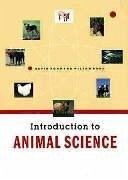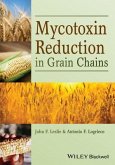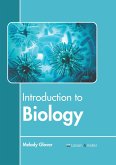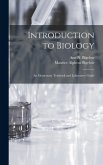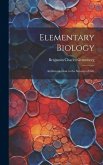- Gebundenes Buch
- Merkliste
- Auf die Merkliste
- Bewerten Bewerten
- Teilen
- Produkt teilen
- Produkterinnerung
- Produkterinnerung
A comprehensive and balanced overview of animal agriculture in contemporary society! It develops the principles of animal biology as a science within the context of life-cycle production of animals for economic and biologic efficiency. Individual chapters describe and analyze particular animal industries such as dairy cattle, poultry, aquatic animals, etc. The book also discusses a wide variety of animal products.
Andere Kunden interessierten sich auch für
![Mycotoxin Reduction in Grain Chains Mycotoxin Reduction in Grain Chains]() Mycotoxin Reduction in Grain Chains242,99 €
Mycotoxin Reduction in Grain Chains242,99 €![Introduction to Developmental Biology Introduction to Developmental Biology]() Introduction to Developmental Biology141,99 €
Introduction to Developmental Biology141,99 €![An Introduction to Living Cells: The Building Blocks of Life An Introduction to Living Cells: The Building Blocks of Life]() Ramesh ChandraAn Introduction to Living Cells: The Building Blocks of Life144,99 €
Ramesh ChandraAn Introduction to Living Cells: The Building Blocks of Life144,99 €![Introduction to Biology Introduction to Biology]() Introduction to Biology135,99 €
Introduction to Biology135,99 €![Introduction to Kinesiology Introduction to Kinesiology]() Marilyn MitchellIntroduction to Kinesiology411,99 €
Marilyn MitchellIntroduction to Kinesiology411,99 €![Introduction to Biology Introduction to Biology]() Maurice Alpheus BigelowIntroduction to Biology42,99 €
Maurice Alpheus BigelowIntroduction to Biology42,99 €![Elementary Biology: An Introduction to the Science of Life Elementary Biology: An Introduction to the Science of Life]() Benjamin Charles GruenbergElementary Biology: An Introduction to the Science of Life43,99 €
Benjamin Charles GruenbergElementary Biology: An Introduction to the Science of Life43,99 €-
-
-
A comprehensive and balanced overview of animal agriculture in contemporary society! It develops the principles of animal biology as a science within the context of life-cycle production of animals for economic and biologic efficiency. Individual chapters describe and analyze particular animal industries such as dairy cattle, poultry, aquatic animals, etc. The book also discusses a wide variety of animal products.
Hinweis: Dieser Artikel kann nur an eine deutsche Lieferadresse ausgeliefert werden.
Hinweis: Dieser Artikel kann nur an eine deutsche Lieferadresse ausgeliefert werden.
Produktdetails
- Produktdetails
- Verlag: Wiley
- Seitenzahl: 736
- Erscheinungstermin: 11. Februar 2000
- Englisch
- Abmessung: 243mm x 197mm x 32mm
- Gewicht: 1297g
- ISBN-13: 9780471170945
- ISBN-10: 0471170941
- Artikelnr.: 21249871
- Herstellerkennzeichnung
- Libri GmbH
- Europaallee 1
- 36244 Bad Hersfeld
- gpsr@libri.de
- Verlag: Wiley
- Seitenzahl: 736
- Erscheinungstermin: 11. Februar 2000
- Englisch
- Abmessung: 243mm x 197mm x 32mm
- Gewicht: 1297g
- ISBN-13: 9780471170945
- ISBN-10: 0471170941
- Artikelnr.: 21249871
- Herstellerkennzeichnung
- Libri GmbH
- Europaallee 1
- 36244 Bad Hersfeld
- gpsr@libri.de
Wilson G. Pond is the author of Introduction to Animal Science, published by Wiley. Kevin R. Pond is the author of Introduction to Animal Science, published by Wiley.
Preface
Section One
Chapter 1 Food Production 1
Historical Perspective 1
Human Population Growth 2
Role of Research and of Land, Water, Soil, and Energy Resources 4
Food Consumption 9
Who Produces the Food? 16
Summary 18
Chapter 2 Domestic Animals 20
An Overview of the Contributions of Domestic Animals 20
Food from Animals 22
Animal Byproducts 23
Pharmaceuticals and Therapeutic Agents 25
Companionship and Pleasure 25
Faithful Stewards 27
Draft Power and Transportation 28
Manure, Crop Residues, and Food Processing Wastes 28
Biomedical Research 31
Summary 31
Chapter 3 Animal Agriculture In The United States And The World 33
Historical Perspective 33
Animal and Crop Production Profiles in the World 33
Animal and Crop Production Profiles in the United States 38
The Place of the United States in World Animal Agriculture 49
Summary 50
Section Two
Chapter 4 Reproduction 52
Gonadotropic Hormones and Their Functions 53
Male Organs of Reproduction and Their Functions 54
Female Organs of Reproduction and Their Functions 59
The Estrous Cycle 63
Pregnancy 65
Parturition 67
Artificial Insemination 69
Estrus Detection 72
Estrus Synchronization 72
Fertilization 73
Embryo Transfer 74
Summary 76
Chapter 5 Lactation 81
The Mammary Gland 81
Milk Synthesis and Secretion 84
Colostrum 86
Milk Composition 87
Milk Production 90
Metabolic Cost of Lactation 95
Summary 96
Chapter 6 Genetics 99
Introduction 99
Genes and Chromosomes of the Cell 100
Mitosis 106
Meiosis 106
Fertilization and Growth 107
Dominant and Recessive Alleles for a Single Trait: Six Possible Outcomes
109
Types of Gene Action 110
Quantitatively Inherited Traits 112
Selection 113
Mating Systems 116
Molecular Genetics 119
Summary 122
Chapter 7 Growth 127
Methods of Expressing Growth 128
Body Weight as a Measure of Growth 129
Hyperplasia, Hypertrophy, and Differentiation 131
Growth of Brain, Skeleton, Muscle, and Adipose Tissue 134
Strategies for Regulating Growth 140
Growth of Placenta, Fetus, and Mammary Tissues in Mammals and Embryo in
Birds 140
Summary 144
Chapter 8 Nutrition And Feeding 146
Nutrients 147
The Gastrointestinal Tract: Structure, Digestion, and Absorption 176
Factors Affecting Feed Consumption 182
Feeds and Feeding 183
Summary 196
Section Three
Chapter 9 Animal Husbandry: Fulfilling Animal Needs 212
Space and Place 213
Thermal Environment 214
Light Environment 219
Environmental Effects on Animal Health 222
Air Pollution in Animal Houses 224
Effects of High Altitude 224
Animal-Human Interactions 225
Animal Accommodations 226
Assessing Environmental Quality 229
Summary 230
Chapter 10 Animal States-Of-Being 232
Domestication and Adaptability 232
Multifaceted Internal and External Environments 233
Environmental Adaptability 236
Animal Needs 238
Inevitable Compromises 242
A Public Issue: Farm-Animal Welfare 243
Summary 247
Chapter 11 New And Emerging Issues 251
Plant-Animal Ecosystems 252
Ecological Balance and Environmental Quality 253
Animal Well-Being 257
Biological Diversity 259
Biotechnology 262
Food Safety 265
Economic Support for Agriculture 268
Challenges and Opportunities for Animal Science Graduates in the
Twenty-first Century 270
Summary 271
Section Four
Chapter 12 Live Animal Evaluation: Beef Cattle, Sheep, And Swine 275
Live Animal Evaluation: Past and Present 276
Beef Cattle Evaluation 277
Sheep Evaluation 286
Swine Evaluation 292
Summary 299
Chapter 13 Dairy Cattle 301
Changes and Trends in the Dairy Industry 302
Dairy Cattle Breeds 306
Milk Marketing 306
Genetic Improvement 308
Housing Systems 310
Herd Health 316
Nutrition and Feeding 316
Reproductive Management 324
Dairy Replacements 326
Economics 329
Summary 332
Chapter 14 Beef Cattle 335
Historical Aspects 336
Cattle Statistics 336
Production System 338
Breeding and Genetic Considerations 342
Reproductive Management 349
Nutritional Management 353
Herd Health Concerns 360
General Management Considerations and Issues 363
Summary 369
Chapter 15 Poultry And Egg Production 373
Integrated Production Systems 374
Reproduction 375
Breeding 377
Incubation 379
Brooding and Rearing 380
Feeding and Nutrition 382
Housing 383
Equipment 388
Lighting Poultry 389
Production Systems 391
Health Maintenance 396
Summary 398
Chapter 16 Horses And The Horse Industry 400
History of the Horse and the Horse Industry in the United States 401
Horse Care and Health Programs 414
Nutrition 419
Housing and Containment 425
Raising Horses 426
Breeding Horses 427
Training Horses 435
Buying and/or Selling a Horse 436
Summary 438
Chapter 17 Swine 441
Description and Characteristics of Swine Production 442
Issues Facing the Pork Industry 447
Pork as Human Food 450
Life Cycle 452
Breeds 456
Applied Genetics 457
Nutrition and Feeding 462
Health 469
Types of Production 470
Husbandry and Management 473
Marketing 479
Emerging Technologies 483
Summary 483
Chapter 18 Sheep And Goats 486
Number of Sheep and Goats 487
Breeds of Sheep and Goats 488
Production Systems 490
Breeding Management 493
Feeding and Nutrition 494
Gestational Concerns 499
Lambing and Kidding Management 502
Growing and Finishing 505
Diseases and Parasites 505
Marketing 507
Summary 507
Chapter 19 Aquatic Animans 510
Evolution of Aquaculture 511
Benefits of Aquaculture 511
Comparison of Feeding Fish versus Livestock 512
Feeding and Nutrition 513
Aquaculture and the Environment 515
Commercial Aquaculture 516
Summary 524
Chapter 20 Dogs And Cats 526
Dogs and Cats in American Society 527
Careers in the pet Industry 529
Nutritional Requirements of Dogs and Cats 530
Basic Health Care 538
Reproduction in the Kennel or Cattery 545
Development and Socialization of Puppies and Kittens 548
Summary 549
Chapter 21 Other Animals, Other Uses, Other Opportunities 553
Animals for Food, Hides, and Fiber 554
Animals Raised for Fur 574
Animals in Research 575
Animals as Tissue and Organ Donors 576
Animals as Pets and Companions 578
Animals in Zoos and Aquariums 579
Summary 580
Section Five
Chapter 22 Meat And Meat Products 584
Modern Methods of Processing Carcasses 585
Distribution of Meat and Meat products 586
Packaging of Retail Meat Cuts 587
The Diet/Health "Scare" for Red Meats and the Response by the Livestock
Industry 588
Low Fat Meats 589
The Other White Meat 589
Slaughter Plant Size 591
Food Safety 592
U.S. Meat Production 593
Meat Inspection 593
Hazard Analysis Critical control points 595
Carcass Composition 595
Composition of Muscle 597
Age, Sex, Weight, Fatness, Grade and Breed Effects on Meat Quality and
Value 599
Effects of Fatness on Meat Palatability 605
Effects of Cooking 607
Why Meat Retail Cuts Differ in Price 608
Summary 610
Chapter 23 Milk And Milk Products 612
Composition of Milk and Dairy Foods 614
Milk Microbiology 616
Milk Processing 621
Processing of Cultured Byproducts 627
Other Products 629
Defects 631
Cleaning and Sanitation of Dairy Plant Systems 633
Operating Efficiencies 635
In-Plant Quality Audits 635
Summary 635
Chapter 24 Poultry And Egg Processing And Products 637
Poultry Meat 637
Eggs 646
Liquid Eggs 650
Summary 652
Chapter 25 Aquaculture Products 654
Importance of Aquaculture Products 654
Nutritional Value of Fish 655
Processing and Marketing and Aquaculture Products 657
Quality 658
Future of Aquaculture Products 660
Summary 660
Chapter 26 Wool Mohair And Other Animal Fibers 663
Wool 663
Mohair 674
Other Animal Fibers 675
Pelts skins and sides 676
Summary 678
Chapter 27 The Future: Animals And Society In The 21st Century 682
Demand for Animal Products 683
Food Resources 684
Trends and Expectations on the Nature of U.S. Animal Agriculture 684
Opportunities in Animal Agriculture 686
Summary 687
Appendices A-1
Index I-1
Section One
Chapter 1 Food Production 1
Historical Perspective 1
Human Population Growth 2
Role of Research and of Land, Water, Soil, and Energy Resources 4
Food Consumption 9
Who Produces the Food? 16
Summary 18
Chapter 2 Domestic Animals 20
An Overview of the Contributions of Domestic Animals 20
Food from Animals 22
Animal Byproducts 23
Pharmaceuticals and Therapeutic Agents 25
Companionship and Pleasure 25
Faithful Stewards 27
Draft Power and Transportation 28
Manure, Crop Residues, and Food Processing Wastes 28
Biomedical Research 31
Summary 31
Chapter 3 Animal Agriculture In The United States And The World 33
Historical Perspective 33
Animal and Crop Production Profiles in the World 33
Animal and Crop Production Profiles in the United States 38
The Place of the United States in World Animal Agriculture 49
Summary 50
Section Two
Chapter 4 Reproduction 52
Gonadotropic Hormones and Their Functions 53
Male Organs of Reproduction and Their Functions 54
Female Organs of Reproduction and Their Functions 59
The Estrous Cycle 63
Pregnancy 65
Parturition 67
Artificial Insemination 69
Estrus Detection 72
Estrus Synchronization 72
Fertilization 73
Embryo Transfer 74
Summary 76
Chapter 5 Lactation 81
The Mammary Gland 81
Milk Synthesis and Secretion 84
Colostrum 86
Milk Composition 87
Milk Production 90
Metabolic Cost of Lactation 95
Summary 96
Chapter 6 Genetics 99
Introduction 99
Genes and Chromosomes of the Cell 100
Mitosis 106
Meiosis 106
Fertilization and Growth 107
Dominant and Recessive Alleles for a Single Trait: Six Possible Outcomes
109
Types of Gene Action 110
Quantitatively Inherited Traits 112
Selection 113
Mating Systems 116
Molecular Genetics 119
Summary 122
Chapter 7 Growth 127
Methods of Expressing Growth 128
Body Weight as a Measure of Growth 129
Hyperplasia, Hypertrophy, and Differentiation 131
Growth of Brain, Skeleton, Muscle, and Adipose Tissue 134
Strategies for Regulating Growth 140
Growth of Placenta, Fetus, and Mammary Tissues in Mammals and Embryo in
Birds 140
Summary 144
Chapter 8 Nutrition And Feeding 146
Nutrients 147
The Gastrointestinal Tract: Structure, Digestion, and Absorption 176
Factors Affecting Feed Consumption 182
Feeds and Feeding 183
Summary 196
Section Three
Chapter 9 Animal Husbandry: Fulfilling Animal Needs 212
Space and Place 213
Thermal Environment 214
Light Environment 219
Environmental Effects on Animal Health 222
Air Pollution in Animal Houses 224
Effects of High Altitude 224
Animal-Human Interactions 225
Animal Accommodations 226
Assessing Environmental Quality 229
Summary 230
Chapter 10 Animal States-Of-Being 232
Domestication and Adaptability 232
Multifaceted Internal and External Environments 233
Environmental Adaptability 236
Animal Needs 238
Inevitable Compromises 242
A Public Issue: Farm-Animal Welfare 243
Summary 247
Chapter 11 New And Emerging Issues 251
Plant-Animal Ecosystems 252
Ecological Balance and Environmental Quality 253
Animal Well-Being 257
Biological Diversity 259
Biotechnology 262
Food Safety 265
Economic Support for Agriculture 268
Challenges and Opportunities for Animal Science Graduates in the
Twenty-first Century 270
Summary 271
Section Four
Chapter 12 Live Animal Evaluation: Beef Cattle, Sheep, And Swine 275
Live Animal Evaluation: Past and Present 276
Beef Cattle Evaluation 277
Sheep Evaluation 286
Swine Evaluation 292
Summary 299
Chapter 13 Dairy Cattle 301
Changes and Trends in the Dairy Industry 302
Dairy Cattle Breeds 306
Milk Marketing 306
Genetic Improvement 308
Housing Systems 310
Herd Health 316
Nutrition and Feeding 316
Reproductive Management 324
Dairy Replacements 326
Economics 329
Summary 332
Chapter 14 Beef Cattle 335
Historical Aspects 336
Cattle Statistics 336
Production System 338
Breeding and Genetic Considerations 342
Reproductive Management 349
Nutritional Management 353
Herd Health Concerns 360
General Management Considerations and Issues 363
Summary 369
Chapter 15 Poultry And Egg Production 373
Integrated Production Systems 374
Reproduction 375
Breeding 377
Incubation 379
Brooding and Rearing 380
Feeding and Nutrition 382
Housing 383
Equipment 388
Lighting Poultry 389
Production Systems 391
Health Maintenance 396
Summary 398
Chapter 16 Horses And The Horse Industry 400
History of the Horse and the Horse Industry in the United States 401
Horse Care and Health Programs 414
Nutrition 419
Housing and Containment 425
Raising Horses 426
Breeding Horses 427
Training Horses 435
Buying and/or Selling a Horse 436
Summary 438
Chapter 17 Swine 441
Description and Characteristics of Swine Production 442
Issues Facing the Pork Industry 447
Pork as Human Food 450
Life Cycle 452
Breeds 456
Applied Genetics 457
Nutrition and Feeding 462
Health 469
Types of Production 470
Husbandry and Management 473
Marketing 479
Emerging Technologies 483
Summary 483
Chapter 18 Sheep And Goats 486
Number of Sheep and Goats 487
Breeds of Sheep and Goats 488
Production Systems 490
Breeding Management 493
Feeding and Nutrition 494
Gestational Concerns 499
Lambing and Kidding Management 502
Growing and Finishing 505
Diseases and Parasites 505
Marketing 507
Summary 507
Chapter 19 Aquatic Animans 510
Evolution of Aquaculture 511
Benefits of Aquaculture 511
Comparison of Feeding Fish versus Livestock 512
Feeding and Nutrition 513
Aquaculture and the Environment 515
Commercial Aquaculture 516
Summary 524
Chapter 20 Dogs And Cats 526
Dogs and Cats in American Society 527
Careers in the pet Industry 529
Nutritional Requirements of Dogs and Cats 530
Basic Health Care 538
Reproduction in the Kennel or Cattery 545
Development and Socialization of Puppies and Kittens 548
Summary 549
Chapter 21 Other Animals, Other Uses, Other Opportunities 553
Animals for Food, Hides, and Fiber 554
Animals Raised for Fur 574
Animals in Research 575
Animals as Tissue and Organ Donors 576
Animals as Pets and Companions 578
Animals in Zoos and Aquariums 579
Summary 580
Section Five
Chapter 22 Meat And Meat Products 584
Modern Methods of Processing Carcasses 585
Distribution of Meat and Meat products 586
Packaging of Retail Meat Cuts 587
The Diet/Health "Scare" for Red Meats and the Response by the Livestock
Industry 588
Low Fat Meats 589
The Other White Meat 589
Slaughter Plant Size 591
Food Safety 592
U.S. Meat Production 593
Meat Inspection 593
Hazard Analysis Critical control points 595
Carcass Composition 595
Composition of Muscle 597
Age, Sex, Weight, Fatness, Grade and Breed Effects on Meat Quality and
Value 599
Effects of Fatness on Meat Palatability 605
Effects of Cooking 607
Why Meat Retail Cuts Differ in Price 608
Summary 610
Chapter 23 Milk And Milk Products 612
Composition of Milk and Dairy Foods 614
Milk Microbiology 616
Milk Processing 621
Processing of Cultured Byproducts 627
Other Products 629
Defects 631
Cleaning and Sanitation of Dairy Plant Systems 633
Operating Efficiencies 635
In-Plant Quality Audits 635
Summary 635
Chapter 24 Poultry And Egg Processing And Products 637
Poultry Meat 637
Eggs 646
Liquid Eggs 650
Summary 652
Chapter 25 Aquaculture Products 654
Importance of Aquaculture Products 654
Nutritional Value of Fish 655
Processing and Marketing and Aquaculture Products 657
Quality 658
Future of Aquaculture Products 660
Summary 660
Chapter 26 Wool Mohair And Other Animal Fibers 663
Wool 663
Mohair 674
Other Animal Fibers 675
Pelts skins and sides 676
Summary 678
Chapter 27 The Future: Animals And Society In The 21st Century 682
Demand for Animal Products 683
Food Resources 684
Trends and Expectations on the Nature of U.S. Animal Agriculture 684
Opportunities in Animal Agriculture 686
Summary 687
Appendices A-1
Index I-1
Preface
Section One
Chapter 1 Food Production 1
Historical Perspective 1
Human Population Growth 2
Role of Research and of Land, Water, Soil, and Energy Resources 4
Food Consumption 9
Who Produces the Food? 16
Summary 18
Chapter 2 Domestic Animals 20
An Overview of the Contributions of Domestic Animals 20
Food from Animals 22
Animal Byproducts 23
Pharmaceuticals and Therapeutic Agents 25
Companionship and Pleasure 25
Faithful Stewards 27
Draft Power and Transportation 28
Manure, Crop Residues, and Food Processing Wastes 28
Biomedical Research 31
Summary 31
Chapter 3 Animal Agriculture In The United States And The World 33
Historical Perspective 33
Animal and Crop Production Profiles in the World 33
Animal and Crop Production Profiles in the United States 38
The Place of the United States in World Animal Agriculture 49
Summary 50
Section Two
Chapter 4 Reproduction 52
Gonadotropic Hormones and Their Functions 53
Male Organs of Reproduction and Their Functions 54
Female Organs of Reproduction and Their Functions 59
The Estrous Cycle 63
Pregnancy 65
Parturition 67
Artificial Insemination 69
Estrus Detection 72
Estrus Synchronization 72
Fertilization 73
Embryo Transfer 74
Summary 76
Chapter 5 Lactation 81
The Mammary Gland 81
Milk Synthesis and Secretion 84
Colostrum 86
Milk Composition 87
Milk Production 90
Metabolic Cost of Lactation 95
Summary 96
Chapter 6 Genetics 99
Introduction 99
Genes and Chromosomes of the Cell 100
Mitosis 106
Meiosis 106
Fertilization and Growth 107
Dominant and Recessive Alleles for a Single Trait: Six Possible Outcomes
109
Types of Gene Action 110
Quantitatively Inherited Traits 112
Selection 113
Mating Systems 116
Molecular Genetics 119
Summary 122
Chapter 7 Growth 127
Methods of Expressing Growth 128
Body Weight as a Measure of Growth 129
Hyperplasia, Hypertrophy, and Differentiation 131
Growth of Brain, Skeleton, Muscle, and Adipose Tissue 134
Strategies for Regulating Growth 140
Growth of Placenta, Fetus, and Mammary Tissues in Mammals and Embryo in
Birds 140
Summary 144
Chapter 8 Nutrition And Feeding 146
Nutrients 147
The Gastrointestinal Tract: Structure, Digestion, and Absorption 176
Factors Affecting Feed Consumption 182
Feeds and Feeding 183
Summary 196
Section Three
Chapter 9 Animal Husbandry: Fulfilling Animal Needs 212
Space and Place 213
Thermal Environment 214
Light Environment 219
Environmental Effects on Animal Health 222
Air Pollution in Animal Houses 224
Effects of High Altitude 224
Animal-Human Interactions 225
Animal Accommodations 226
Assessing Environmental Quality 229
Summary 230
Chapter 10 Animal States-Of-Being 232
Domestication and Adaptability 232
Multifaceted Internal and External Environments 233
Environmental Adaptability 236
Animal Needs 238
Inevitable Compromises 242
A Public Issue: Farm-Animal Welfare 243
Summary 247
Chapter 11 New And Emerging Issues 251
Plant-Animal Ecosystems 252
Ecological Balance and Environmental Quality 253
Animal Well-Being 257
Biological Diversity 259
Biotechnology 262
Food Safety 265
Economic Support for Agriculture 268
Challenges and Opportunities for Animal Science Graduates in the
Twenty-first Century 270
Summary 271
Section Four
Chapter 12 Live Animal Evaluation: Beef Cattle, Sheep, And Swine 275
Live Animal Evaluation: Past and Present 276
Beef Cattle Evaluation 277
Sheep Evaluation 286
Swine Evaluation 292
Summary 299
Chapter 13 Dairy Cattle 301
Changes and Trends in the Dairy Industry 302
Dairy Cattle Breeds 306
Milk Marketing 306
Genetic Improvement 308
Housing Systems 310
Herd Health 316
Nutrition and Feeding 316
Reproductive Management 324
Dairy Replacements 326
Economics 329
Summary 332
Chapter 14 Beef Cattle 335
Historical Aspects 336
Cattle Statistics 336
Production System 338
Breeding and Genetic Considerations 342
Reproductive Management 349
Nutritional Management 353
Herd Health Concerns 360
General Management Considerations and Issues 363
Summary 369
Chapter 15 Poultry And Egg Production 373
Integrated Production Systems 374
Reproduction 375
Breeding 377
Incubation 379
Brooding and Rearing 380
Feeding and Nutrition 382
Housing 383
Equipment 388
Lighting Poultry 389
Production Systems 391
Health Maintenance 396
Summary 398
Chapter 16 Horses And The Horse Industry 400
History of the Horse and the Horse Industry in the United States 401
Horse Care and Health Programs 414
Nutrition 419
Housing and Containment 425
Raising Horses 426
Breeding Horses 427
Training Horses 435
Buying and/or Selling a Horse 436
Summary 438
Chapter 17 Swine 441
Description and Characteristics of Swine Production 442
Issues Facing the Pork Industry 447
Pork as Human Food 450
Life Cycle 452
Breeds 456
Applied Genetics 457
Nutrition and Feeding 462
Health 469
Types of Production 470
Husbandry and Management 473
Marketing 479
Emerging Technologies 483
Summary 483
Chapter 18 Sheep And Goats 486
Number of Sheep and Goats 487
Breeds of Sheep and Goats 488
Production Systems 490
Breeding Management 493
Feeding and Nutrition 494
Gestational Concerns 499
Lambing and Kidding Management 502
Growing and Finishing 505
Diseases and Parasites 505
Marketing 507
Summary 507
Chapter 19 Aquatic Animans 510
Evolution of Aquaculture 511
Benefits of Aquaculture 511
Comparison of Feeding Fish versus Livestock 512
Feeding and Nutrition 513
Aquaculture and the Environment 515
Commercial Aquaculture 516
Summary 524
Chapter 20 Dogs And Cats 526
Dogs and Cats in American Society 527
Careers in the pet Industry 529
Nutritional Requirements of Dogs and Cats 530
Basic Health Care 538
Reproduction in the Kennel or Cattery 545
Development and Socialization of Puppies and Kittens 548
Summary 549
Chapter 21 Other Animals, Other Uses, Other Opportunities 553
Animals for Food, Hides, and Fiber 554
Animals Raised for Fur 574
Animals in Research 575
Animals as Tissue and Organ Donors 576
Animals as Pets and Companions 578
Animals in Zoos and Aquariums 579
Summary 580
Section Five
Chapter 22 Meat And Meat Products 584
Modern Methods of Processing Carcasses 585
Distribution of Meat and Meat products 586
Packaging of Retail Meat Cuts 587
The Diet/Health "Scare" for Red Meats and the Response by the Livestock
Industry 588
Low Fat Meats 589
The Other White Meat 589
Slaughter Plant Size 591
Food Safety 592
U.S. Meat Production 593
Meat Inspection 593
Hazard Analysis Critical control points 595
Carcass Composition 595
Composition of Muscle 597
Age, Sex, Weight, Fatness, Grade and Breed Effects on Meat Quality and
Value 599
Effects of Fatness on Meat Palatability 605
Effects of Cooking 607
Why Meat Retail Cuts Differ in Price 608
Summary 610
Chapter 23 Milk And Milk Products 612
Composition of Milk and Dairy Foods 614
Milk Microbiology 616
Milk Processing 621
Processing of Cultured Byproducts 627
Other Products 629
Defects 631
Cleaning and Sanitation of Dairy Plant Systems 633
Operating Efficiencies 635
In-Plant Quality Audits 635
Summary 635
Chapter 24 Poultry And Egg Processing And Products 637
Poultry Meat 637
Eggs 646
Liquid Eggs 650
Summary 652
Chapter 25 Aquaculture Products 654
Importance of Aquaculture Products 654
Nutritional Value of Fish 655
Processing and Marketing and Aquaculture Products 657
Quality 658
Future of Aquaculture Products 660
Summary 660
Chapter 26 Wool Mohair And Other Animal Fibers 663
Wool 663
Mohair 674
Other Animal Fibers 675
Pelts skins and sides 676
Summary 678
Chapter 27 The Future: Animals And Society In The 21st Century 682
Demand for Animal Products 683
Food Resources 684
Trends and Expectations on the Nature of U.S. Animal Agriculture 684
Opportunities in Animal Agriculture 686
Summary 687
Appendices A-1
Index I-1
Section One
Chapter 1 Food Production 1
Historical Perspective 1
Human Population Growth 2
Role of Research and of Land, Water, Soil, and Energy Resources 4
Food Consumption 9
Who Produces the Food? 16
Summary 18
Chapter 2 Domestic Animals 20
An Overview of the Contributions of Domestic Animals 20
Food from Animals 22
Animal Byproducts 23
Pharmaceuticals and Therapeutic Agents 25
Companionship and Pleasure 25
Faithful Stewards 27
Draft Power and Transportation 28
Manure, Crop Residues, and Food Processing Wastes 28
Biomedical Research 31
Summary 31
Chapter 3 Animal Agriculture In The United States And The World 33
Historical Perspective 33
Animal and Crop Production Profiles in the World 33
Animal and Crop Production Profiles in the United States 38
The Place of the United States in World Animal Agriculture 49
Summary 50
Section Two
Chapter 4 Reproduction 52
Gonadotropic Hormones and Their Functions 53
Male Organs of Reproduction and Their Functions 54
Female Organs of Reproduction and Their Functions 59
The Estrous Cycle 63
Pregnancy 65
Parturition 67
Artificial Insemination 69
Estrus Detection 72
Estrus Synchronization 72
Fertilization 73
Embryo Transfer 74
Summary 76
Chapter 5 Lactation 81
The Mammary Gland 81
Milk Synthesis and Secretion 84
Colostrum 86
Milk Composition 87
Milk Production 90
Metabolic Cost of Lactation 95
Summary 96
Chapter 6 Genetics 99
Introduction 99
Genes and Chromosomes of the Cell 100
Mitosis 106
Meiosis 106
Fertilization and Growth 107
Dominant and Recessive Alleles for a Single Trait: Six Possible Outcomes
109
Types of Gene Action 110
Quantitatively Inherited Traits 112
Selection 113
Mating Systems 116
Molecular Genetics 119
Summary 122
Chapter 7 Growth 127
Methods of Expressing Growth 128
Body Weight as a Measure of Growth 129
Hyperplasia, Hypertrophy, and Differentiation 131
Growth of Brain, Skeleton, Muscle, and Adipose Tissue 134
Strategies for Regulating Growth 140
Growth of Placenta, Fetus, and Mammary Tissues in Mammals and Embryo in
Birds 140
Summary 144
Chapter 8 Nutrition And Feeding 146
Nutrients 147
The Gastrointestinal Tract: Structure, Digestion, and Absorption 176
Factors Affecting Feed Consumption 182
Feeds and Feeding 183
Summary 196
Section Three
Chapter 9 Animal Husbandry: Fulfilling Animal Needs 212
Space and Place 213
Thermal Environment 214
Light Environment 219
Environmental Effects on Animal Health 222
Air Pollution in Animal Houses 224
Effects of High Altitude 224
Animal-Human Interactions 225
Animal Accommodations 226
Assessing Environmental Quality 229
Summary 230
Chapter 10 Animal States-Of-Being 232
Domestication and Adaptability 232
Multifaceted Internal and External Environments 233
Environmental Adaptability 236
Animal Needs 238
Inevitable Compromises 242
A Public Issue: Farm-Animal Welfare 243
Summary 247
Chapter 11 New And Emerging Issues 251
Plant-Animal Ecosystems 252
Ecological Balance and Environmental Quality 253
Animal Well-Being 257
Biological Diversity 259
Biotechnology 262
Food Safety 265
Economic Support for Agriculture 268
Challenges and Opportunities for Animal Science Graduates in the
Twenty-first Century 270
Summary 271
Section Four
Chapter 12 Live Animal Evaluation: Beef Cattle, Sheep, And Swine 275
Live Animal Evaluation: Past and Present 276
Beef Cattle Evaluation 277
Sheep Evaluation 286
Swine Evaluation 292
Summary 299
Chapter 13 Dairy Cattle 301
Changes and Trends in the Dairy Industry 302
Dairy Cattle Breeds 306
Milk Marketing 306
Genetic Improvement 308
Housing Systems 310
Herd Health 316
Nutrition and Feeding 316
Reproductive Management 324
Dairy Replacements 326
Economics 329
Summary 332
Chapter 14 Beef Cattle 335
Historical Aspects 336
Cattle Statistics 336
Production System 338
Breeding and Genetic Considerations 342
Reproductive Management 349
Nutritional Management 353
Herd Health Concerns 360
General Management Considerations and Issues 363
Summary 369
Chapter 15 Poultry And Egg Production 373
Integrated Production Systems 374
Reproduction 375
Breeding 377
Incubation 379
Brooding and Rearing 380
Feeding and Nutrition 382
Housing 383
Equipment 388
Lighting Poultry 389
Production Systems 391
Health Maintenance 396
Summary 398
Chapter 16 Horses And The Horse Industry 400
History of the Horse and the Horse Industry in the United States 401
Horse Care and Health Programs 414
Nutrition 419
Housing and Containment 425
Raising Horses 426
Breeding Horses 427
Training Horses 435
Buying and/or Selling a Horse 436
Summary 438
Chapter 17 Swine 441
Description and Characteristics of Swine Production 442
Issues Facing the Pork Industry 447
Pork as Human Food 450
Life Cycle 452
Breeds 456
Applied Genetics 457
Nutrition and Feeding 462
Health 469
Types of Production 470
Husbandry and Management 473
Marketing 479
Emerging Technologies 483
Summary 483
Chapter 18 Sheep And Goats 486
Number of Sheep and Goats 487
Breeds of Sheep and Goats 488
Production Systems 490
Breeding Management 493
Feeding and Nutrition 494
Gestational Concerns 499
Lambing and Kidding Management 502
Growing and Finishing 505
Diseases and Parasites 505
Marketing 507
Summary 507
Chapter 19 Aquatic Animans 510
Evolution of Aquaculture 511
Benefits of Aquaculture 511
Comparison of Feeding Fish versus Livestock 512
Feeding and Nutrition 513
Aquaculture and the Environment 515
Commercial Aquaculture 516
Summary 524
Chapter 20 Dogs And Cats 526
Dogs and Cats in American Society 527
Careers in the pet Industry 529
Nutritional Requirements of Dogs and Cats 530
Basic Health Care 538
Reproduction in the Kennel or Cattery 545
Development and Socialization of Puppies and Kittens 548
Summary 549
Chapter 21 Other Animals, Other Uses, Other Opportunities 553
Animals for Food, Hides, and Fiber 554
Animals Raised for Fur 574
Animals in Research 575
Animals as Tissue and Organ Donors 576
Animals as Pets and Companions 578
Animals in Zoos and Aquariums 579
Summary 580
Section Five
Chapter 22 Meat And Meat Products 584
Modern Methods of Processing Carcasses 585
Distribution of Meat and Meat products 586
Packaging of Retail Meat Cuts 587
The Diet/Health "Scare" for Red Meats and the Response by the Livestock
Industry 588
Low Fat Meats 589
The Other White Meat 589
Slaughter Plant Size 591
Food Safety 592
U.S. Meat Production 593
Meat Inspection 593
Hazard Analysis Critical control points 595
Carcass Composition 595
Composition of Muscle 597
Age, Sex, Weight, Fatness, Grade and Breed Effects on Meat Quality and
Value 599
Effects of Fatness on Meat Palatability 605
Effects of Cooking 607
Why Meat Retail Cuts Differ in Price 608
Summary 610
Chapter 23 Milk And Milk Products 612
Composition of Milk and Dairy Foods 614
Milk Microbiology 616
Milk Processing 621
Processing of Cultured Byproducts 627
Other Products 629
Defects 631
Cleaning and Sanitation of Dairy Plant Systems 633
Operating Efficiencies 635
In-Plant Quality Audits 635
Summary 635
Chapter 24 Poultry And Egg Processing And Products 637
Poultry Meat 637
Eggs 646
Liquid Eggs 650
Summary 652
Chapter 25 Aquaculture Products 654
Importance of Aquaculture Products 654
Nutritional Value of Fish 655
Processing and Marketing and Aquaculture Products 657
Quality 658
Future of Aquaculture Products 660
Summary 660
Chapter 26 Wool Mohair And Other Animal Fibers 663
Wool 663
Mohair 674
Other Animal Fibers 675
Pelts skins and sides 676
Summary 678
Chapter 27 The Future: Animals And Society In The 21st Century 682
Demand for Animal Products 683
Food Resources 684
Trends and Expectations on the Nature of U.S. Animal Agriculture 684
Opportunities in Animal Agriculture 686
Summary 687
Appendices A-1
Index I-1

